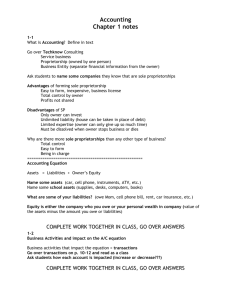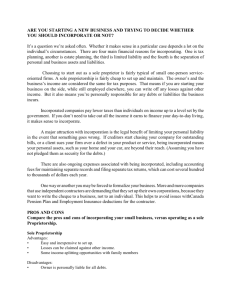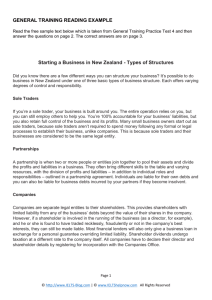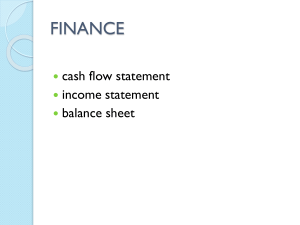Accounts Payable are the total amounts your business
advertisement
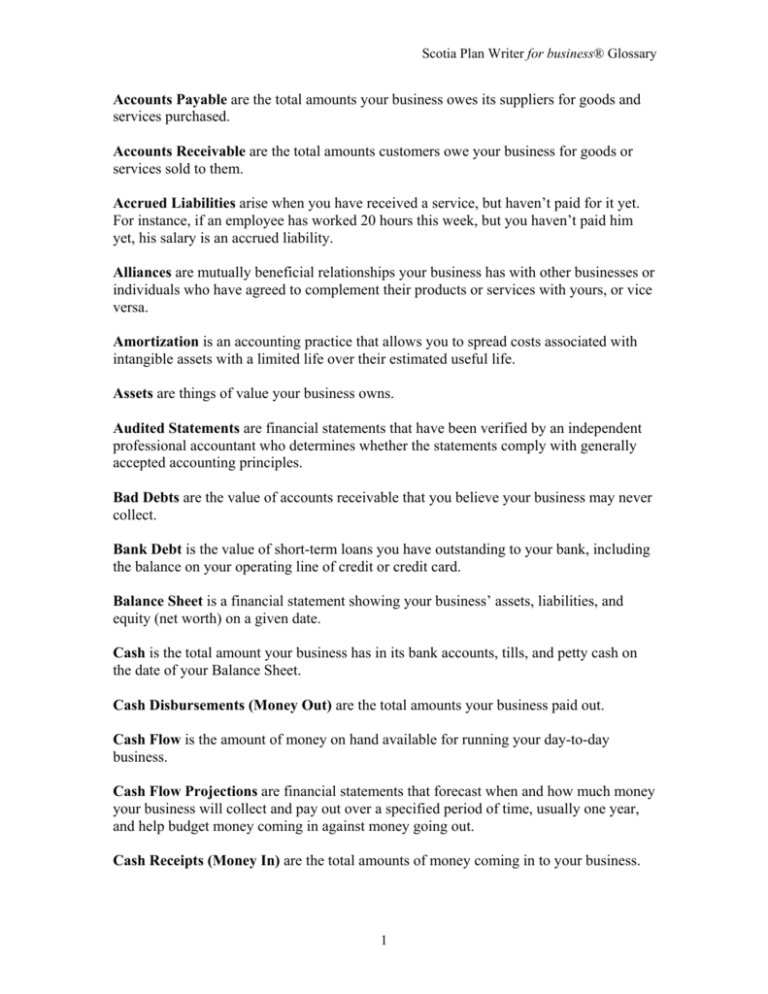
Scotia Plan Writer for business® Glossary Accounts Payable are the total amounts your business owes its suppliers for goods and services purchased. Accounts Receivable are the total amounts customers owe your business for goods or services sold to them. Accrued Liabilities arise when you have received a service, but haven’t paid for it yet. For instance, if an employee has worked 20 hours this week, but you haven’t paid him yet, his salary is an accrued liability. Alliances are mutually beneficial relationships your business has with other businesses or individuals who have agreed to complement their products or services with yours, or vice versa. Amortization is an accounting practice that allows you to spread costs associated with intangible assets with a limited life over their estimated useful life. Assets are things of value your business owns. Audited Statements are financial statements that have been verified by an independent professional accountant who determines whether the statements comply with generally accepted accounting principles. Bad Debts are the value of accounts receivable that you believe your business may never collect. Bank Debt is the value of short-term loans you have outstanding to your bank, including the balance on your operating line of credit or credit card. Balance Sheet is a financial statement showing your business’ assets, liabilities, and equity (net worth) on a given date. Cash is the total amount your business has in its bank accounts, tills, and petty cash on the date of your Balance Sheet. Cash Disbursements (Money Out) are the total amounts your business paid out. Cash Flow is the amount of money on hand available for running your day-to-day business. Cash Flow Projections are financial statements that forecast when and how much money your business will collect and pay out over a specified period of time, usually one year, and help budget money coming in against money going out. Cash Receipts (Money In) are the total amounts of money coming in to your business. 1 Scotia Plan Writer for business® Glossary Cash Sales are the amounts paid by customers immediately at the time of sale. It can include payments made by cash, cheque, credit card or debit card. Competitive Advantage is what makes your business unique and difficult for competitors to imitate. Cost of Goods Sold is the cost to your business directly related to purchasing or manufacturing the products you sell. It does not include general administration or other indirect costs. Credit Terms are the agreed-upon parameters that dictate when and how much your customers pay you for goods or services they don’t pay for immediately at the time of purchase (or, alternatively, when and how much you pay your suppliers for purchases you make on account). Credit terms usually include a period of time during which payment must be made (e.g. 30 days), and sometimes include a discount for payment within a certain period of time. Current Assets are things your business owns that can readily be turned into cash, or which you expect to turn into cash as part of the normal course of business during the next 12 months. Current Liabilities are debts you need to pay off in the next 12 months. Current Ratio is calculated as current assets divided by current liabilities. It is a measure of your business’ liquidity, or the availability of cash or assets that can be converted easily to cash to run the business and meet short-term obligations. Debt to Equity Ratio compares the level of financing provided by creditors to the amount that owners have invested in the business, by dividing total liabilities by owner’s or shareholder’s equity. Depreciation is an accounting practice that allows you to reflect that fixed assets wear out or become obsolete over time, by spreading out the cost of buying a fixed asset over the asset’s useful life. Direct Costs are amounts paid to suppliers for products or services that you intend to resell to your customers. For example, a contractor would include all amounts paid to subcontractors for job-related work during the year. Dividends or Owner’s Draw is the amount taken out of a business’ retained earnings by owners. In a sole proprietorship or partnership, this is called “owner’s draw”. In an incorporated business, where the money is distributed among shareholders, it is called “dividends”. Ending Inventory is the amount your business has in inventory at the end of the period covered by your Income Statement. 2 Scotia Plan Writer for business® Glossary Equipment are fixed assets, including vehicles, that your business owns. Equipment should be recorded on your Balance Sheet at the amount you paid to acquire it. It is subject to depreciation. Equity is the difference between a business’ assets and liabilities. It includes money that owners or shareholders have contributed to the business and profits that have been reinvested in it. For a sole proprietorship or partnership, this is often called “owner’s equity”. For an incorporated business, it can be referred to as “shareholder’s equity”. Equity Contributions / Capital Stock represents the amount of money (equity) owners, partners, or shareholders have invested in the business, excluding owner’s – or shareholder’s – loans. For sole proprietorships or partnerships, this is known as “cash equity contributions”. For incorporated companies, it is known as “capital stock”. Fixed Assets, also called capital assets, are long-term assets that you expect will still be helping your business make money beyond the next twelve months, like land, buildings, equipment, and other items you use in your business operations. With the exception of land, which is always listed at its cost, all fixed assets are subject to depreciation. General Partnership is a legal structure of a business, where two or more people or companies pool talents and resources, and share ownership of all assets and liability for all debts of the business. Gross Profit is the difference between sales and cost of goods sold. It’s the amount your business has left over to cover all remaining expenses and taxes. Gross Profit Margin captures the relationship between sales and cost of goods sold. It’s the percentage of every dollar in sales you have left over after paying direct costs for manufacturing or acquiring goods sold, to cover all remaining expenses and taxes. Income Statement is a financial statement that presents your business’ revenues (also called sales), expenses, and net income over a specified period of time, usually one year. Incorporated Company is a legal structure for a business, where the liability of owners, who are called “shareholders”, is limited to the amount of their financial investment in the business. Intangible Assets / Goodwill are things your business owns that have value, but that you can’t touch or feel – like licences, copyrights, trademarks, patents, proprietary customer lists, service contracts, goodwill and brands. Interest Expense reflects the cost of borrowing money. It is the amount you pay in interest on your business borrowings during a specified period, and may include interest on your operating line of credit, term loans, credit card balances, and loans from finance companies and other lenders. 3 Scotia Plan Writer for business® Glossary Inventory is the raw materials, partially completed products, and finished goods that your business is currently holding to sell to your customers. Investments that are listed as current assets on your Balance Sheet include stocks and bonds that can be readily sold for cash. Land and Buildings are long-term, fixed assets on the Balance Sheet. For accounting purposes, land is listed at the cost you paid to acquire it, while buildings are subject to depreciation. Legal Name is the name of your business that appears on official documents. For a sole proprietorship, it may be the legal name of the owner or a registered business name. (For banking purposes, the legal name of a sole proprietorship is the business owner’s legal name.) For a partnership, it may be either the legal names of the partners or a registered business name. For an incorporated business, it is the registered business name, shown on its incorporating documents, which ends with words such as “Incorporated”, “Inc.”, “Limited”, “Ltd.”. “Corporation”, or “Corp.”. Liabilities are what your business owes to creditors, suppliers, and customers. Limited Partnership is a business structure, where there are two kinds of partners: general partners who manage the business and are personally liable for debts, and limited partners whose participation in the business is limited to investing money, and whose liability is consequently limited to their investment in the business. Liquidity is your business’ ability to meet current obligations using assets that can be quickly turned into cash. Loan Proceeds include any money you receive from new loans to your business. Long-Term Debt is the total amount you owe on long-term loans, including mortgages. The amount due in the next 12 months, called the current portion of long-term debt, is listed as a current liability on your Balance Sheet. The portion not due to be repaid in the next 12 months is listed as a long-term liability. Long-Term Investments include investments that have a term longer than one year, as well as loans extended by your business that you don’t expect to collect in the next 12 months. Long-Term Liabilities are debts that will not be repaid within the next 12 months. 4 Scotia Plan Writer for business® Glossary Market Share is the relative size of one business’ portion of the market. In percentage terms, it is one business’ sales of a particular product or service divided by the total sales for that product or service in the marketplace. Net Fixed Assets are the amounts you paid for your business’ fixed assets, minus depreciation. Net Income, also called Net Profit or loss, is equal to total sales (revenue) minus all business expenses, including income taxes. Net Profit Margin is the percentage of each dollar of sales that remains after all expenses have been deducted. Opening Inventory is the amount your business has in inventory at the start of the accounting period your Income Statement covers. Operating Line of Credit is a short-term loan to cover day-to-day operating expenses of a business. It allows a borrower to continuously borrow and repay a loan up to an agreed limit. Owner’s Draw or Dividends is the amount taken out of a business’ retained earnings by owners. In a sole proprietorship or partnership, this is called “owner’s draw”. In an incorporated business, where the money is distributed among shareholders, it is called “dividends”. Owner’s Equity Contributions include all monies that owners, partners, or shareholders inject into your business, excluding owner’s/shareholder’s loans. Owner’s/Shareholder’s Loans are the amounts owed to you, your partners, or other shareholders for loans made to your business, which are expected to be repaid. For sole proprietorships or partnerships, these are known as “owner’s loans”. For incorporated businesses, they are known as “shareholder’s loans”. Prepaid Expenses are items your business has paid for, but hasn’t yet received the benefit of. Pro Forma Statements are financial statements that show the projected financial status of a business, assuming certain events will take place. Purchase of Materials or Stock includes amounts paid to purchase raw materials, partially finished goods, and finished goods for later sale. Purchases are costs paid to suppliers for raw materials used to produce the goods you sell or finished goods which you intend to resell to your customers. 5 Scotia Plan Writer for business® Glossary Retained Earnings are the accumulation of all profits (after tax) that have not been removed from your business. If your business shows a loss, its retained earnings will be reduced. Return on Equity Ratio measures the return your business generates for owners who have invested in it. Review Engagement Statements are financial statements that have been reviewed by an independent accountant who determines whether they are plausible within the framework of generally accepted accounting principles. A review engagement is similar to an audit, except that no opinion is expressed on the statements. Sales, also called Revenues, are the amounts you billed customers for products or services they purchased. Short-Term Debt is the amount your business owes on loans that are due to be repaid within one year, including the balances outstanding on your company’s operating line of credit and credit cards. Sole Proprietorship is a legal structure of a business, where the business is wholly owned by one person, called the sole proprietor. The business owner and the business are not separate legal entities, which means the sole proprietor personally owns the business’ assets and is liable for all business debts. Statement of Net Worth is a personal financial statement that shows your personal assets, liabilities, and net worth on a given date. Taxes Payable are amounts your business owes in taxes, but hasn’t paid yet. Tax Rate is the percentage of your net profit before tax that you’ll be required to pay in taxes. Only incorporated businesses show and subtract income tax on their Income Statements. Term Financing describes loans, usually taken out to make a specific purchase, that must be repaid according to a fixed schedule, by a certain date. Trade Name is the name your business “goes by,” which can be different from its legal name. For example, a sole proprietor “John B. Smith” could trade as “John’s Pizzeria”. 887905 Ontario Inc. could trade as “Jill’s Hair Salon.” 6
